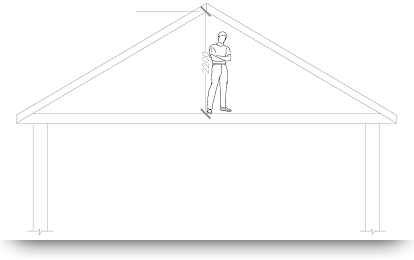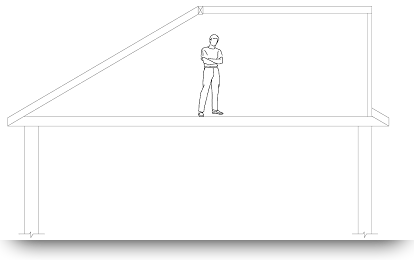Loft Conversion Guide
The first thing to check for is that you have enough headroom. As a rule you should have a minimum clear 2.2m headroom within the roof from top of the ceiling joists to the ridge (see diagram below).

It is most likely that the ceiling joists will not be robust enough to support floor loads. This is overcome by inserting deeper joists alongside the existing ceiling joists. This has the effect of reducing the headroom. However floor joist sizes can be kept to a minimum by keeping their overall span down. Intelligent use of supporting beam placing can be an effective strategy on keeping floor joist sizing to a minimum.
Useable space in a loft conversion can be further increased by incorporating a dormer.

There are usually planning restrictions on the sizing and positioning of most dormer roofs. Planning Authorities like to see them positioned on the rear of properties and within relatively small proportion to the size of the main roof of the house. As a guide the size of the dormer should represent less than half the distance between the ridge and eaves of the main roof. However many modern houses do not have enough roof space to allow for a useable conversion that a traditional dormer roof can provide. Large flat roofed dormers can be accepted in such circumstances with the right guidance.
If you have a hipped roof another possible solution to create more useable space is to replace the hip end with a gable end i.e. vertical wall. If other similar properties in your neighbourhood have had these done this will put you in good stead in gaining Planning approval.
Not all dormers and changes to the roof structure will require Planning approval.
Please refer to the section on Permitted Development.
If you are converting the loft of a two storey house you should next ensure that your stairs are enclosed on both the ground and first floor. In other words the stairs should not pass through any rooms. This is to ensure that you have a protected escape route from fire all the way from the loft room to the exit at ground floor level. The doors in the stairwell need to be upgraded to provide a minimum of 20 minutes fire protection (including any glazing in the stairwell walls). If this is not possible the doors will need to be replaced with 20 minute rated fire doors.
The exception to a protected escape route is to have two alternative escape routes available on the ground floor. For instance the stair at ground floor level can be provided with partitioning either side with a minimum of two fire doors at ground floor opening into two separate escape routes.
For a loft conversion to a bungalow it is simpler. The newly formed habitable rooms can be provided with a window opening for means of escape. The occupants can then safely jump one storey down to ground level.